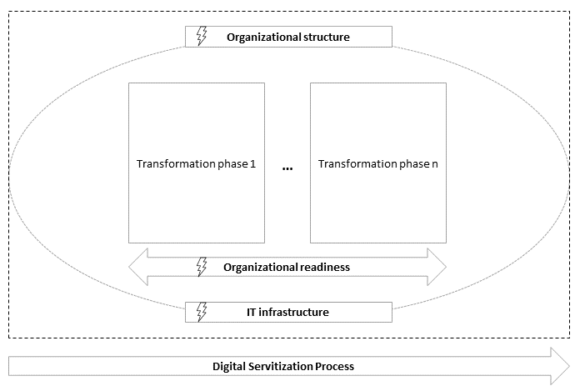
The Power of Automation in Data Migration
Automation is a practical solution to speed up and optimize the entire data migration process
Digital servitization describes the transformation from a product-centric to a service-oriented prioritization in manufacturing companies with the help of digital technologies. Taking the road to digital servitization involves an organizational transformation. Several challenges need to be addressed beforehand to ensure the success of the transformation.
The phenomenon of digital servitization has emerged from two major concepts: servitization and digitalization.
The first mega trend, the so-called servitization, describes the service growth in the manufacturing industry. Whether it is within a B2B or B2C context – customer needs are constantly changing, commoditization is pervasive, and competition on global markets steadily increases. Therefore, physical products and services are more often provided in an integrated solution offering.
The second mega trend refers to digitalization. Especially within the context of servitization, products nowadays are more often linked with software and analytics to make them smarter and more connected. The “digital wave” is changing the provision of services and new business models evolve.
Digital servitization is the combination of the above-mentioned trends. Either digital components are embedded in physical products (e.g., sensors) or new services are developed and/or existing ones are improved by digital technologies (like IoT, big data and analytics, cloud computing). In this regard, particularly organizational structures, ways of thinking as well as processes, principles and value chains must be adapted. However, it is a huge undertaking to put this into practice, and it poses several challenges to managers which need to be solved.
In many cases, organizations are not well enough prepared for this transformation. Figure 1 shows three major challenges for manufacturing companies within the digital servitization process.

Firstly, adjusting organizational structures in rather traditional, hierarchical companies are long-term processes which can stretch over years. Organizational and structural change is needed, which should promote transparency within organizations and drive harmonization and standardization. Considering the digital servitization process, the organizational structure of a manufacturing company can have an accelerating as well as an inhibiting effect on the transformation phases.
The second challenge is the IT infrastructure. Manufacturing companies lose speed in the transformation if systems are not harmonized, or data infrastructures and data objects are not standardized. This can often be seen in organizations that have grown bigger and bigger over the years. They have accumulated numerous systems in this time, and they lack a future-proof data-architecture.
Thirdly, the organizational readiness has an enormous impact on the transformation and must be ensured continuously throughout all phases of the transformation. Digital servitization requires investments which fundamentally rely on a high level of management support. However, the most difficult challenge is the holistic integration of the whole organization in the change. A rather old and traditional way of thinking can negatively impact the transformation process. Digital servitization aims at a customer-centric focus, therefore it proves to be exceedingly problematic if a predominantly product-centric mindset prevails. Also, an unfavorable organizational structure can have negative effects on the organizational readiness, e.g., on the motivation and mindset of the workforce as well as on management’s willingness to invest.
It cannot be denied that the transformation towards digital servitization is an organization-wide transformation process which requires the right measurements. Since internal inconsistencies, e.g., between strategy and organizational structure or IT infrastructure, may occur, it is necessary to have experts on board who guide you through this change process.
Since digitalization must happen everywhere, a fit-for-purpose organizational structure is irreversible to ensure a successful and sustainable transformation. The transformations’ dimensions need to be understood as well as how they are impacted by various external and internal factors. Thereby it is essential that digital servitization goals are pursued with a long-term perspective and that digitalization aspects are not only defined in the strategy but are also driven forward within organizations on an operational level.
Most importantly however, is the people-side of every transformation. Too often, this aspect is forgotten so that the desired change cannot be established sustainably. An organizational change management approach is required which includes a change in behavior as well as in culture. Especially for digital servitization, new and agile ways of thinking need to be formed. To shape this mindset, internal structures need to be navigated towards digital servitization and synergies need to be created. This mindset-change is only successful if the workforce is actively involved in the change process.
Digital Servitization is a complex and challenging process. Management must make increased efforts to overcome these. It is important to keep in mind that adapting the organization and be able to ultimately scale digital solutions is a long-term process.
Camelot supports you in reducing the complexity of the transformation towards Digital Servitization and in mastering this holistic organizational change. Don’t hesitate to get in touch with us.
We would like to thank Elisa Große Holz for her valuable contribution to this article.

Automation is a practical solution to speed up and optimize the entire data migration process

Discover how you can streamline your financial master data management and reengineer financial processes with SAP MDG Finance.

Whilst it seems straightforward to carry out either a blood transfusion or a data migration, the actuality proves far more complex.

In this blog article, Camelot introduces you to the main principals of Demand-Driven Supply Chain Management.